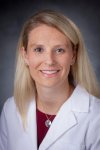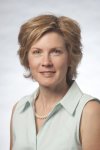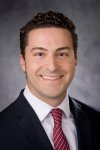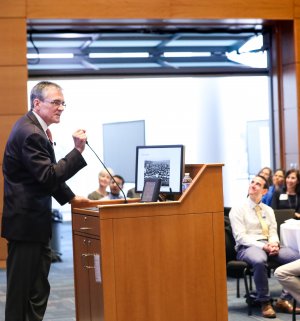Creating a Culture of Interprofessional Education

Traditionally, nursing students go to school with fellow nursing students, learning from nursing faculty in the classroom and experienced nurses in the hospital and clinic. The same pattern goes for students in other health care fields, such as medicine and physical therapy. This is how professional schools work — practical and logistical.
The reality however, is that once students graduate and take professional positions, they quickly discover that most organizations require interprofessional teamwork. Research conducted over the last decade shows that the trend toward interprofessional patient care results in better health outcomes. Duke Health, via a collaborative effort between Duke University Schools of Nursing and Medicine, is responding to that trend head-on, creating the Duke Health Center for Interprofessional Education and Care (IPEC).
Mitchell T. Heflin, MD, MSA, MHS, professor of medicine, was named director of the new center in July, charged with helping to change the way health education across professions operates. “Health professions are still educated in silos,” Heflin said. “And professional identities are based on that education. It isn’t until health professionals cross paths more spontaneously with other professionals during clinical interactions that they begin to develop their understanding of others, not necessarily through deliberate learning experiences.”
As a leader in health education, the goal of Duke’s IPEC Center is to build bridges across the silo model, creating intentional interprofessional learning experiences so that Duke students graduate with a deeper understanding of their peers, confident with and better able to deliver team-based patient care. Heflin has assembled an Executive Advisory Committee to assist early on with issues regarding Center structure, staffing, and priorities. He see this Committee playing a critical role in the Center’s ongoing strategic planning process.
A Fresh Approach to Complex Challenges
“We have seen an increase in complexity with respect to the health problems that people have,” Heflin said. “To meet these challenges, we have embraced a population-based approach that emphasizes quality and safety as well as patient experiences. All these factors lend themselves to the work of an interprofessional team.”
The IPEC Center is designed to serve students from all of Duke’s academic programs (ABSN, MSN, DNP, PhD) as well as doctor of medicine, doctor of physical therapy and physician assistant programs. The building will become the focal point of educational activities for these programs.




 Heflin has assembled a team of five to represent the different professions. In addition to administrative assistant Cindy Luddy, Heflin’s team includes four assistant directors: Nicholas Hudak, MSEd, MPA, PA-C, associate professor, Department of Family Medicine and Community Health Physician Assistant Program; Amy Pastva, PT, MA, PhD, assistant professor, Department of Orthopedic Surgery, Division of Physical Therapy, Department of Health Sciences; Margory Molloy, DNP, RN, CNE, CHSE, assistant professor, School of Nursing, director, Center for Nursing Discovery; and Erin Leiman, MD, assistant professor, Department of Surgery, Division of Emergency Medicine. This group will collaborate to create a strategic plan for the center that includes incorporating the core competencies required by the Interprofessional Education Collaborative (IPEC), a national group of health education associations.
Heflin has assembled a team of five to represent the different professions. In addition to administrative assistant Cindy Luddy, Heflin’s team includes four assistant directors: Nicholas Hudak, MSEd, MPA, PA-C, associate professor, Department of Family Medicine and Community Health Physician Assistant Program; Amy Pastva, PT, MA, PhD, assistant professor, Department of Orthopedic Surgery, Division of Physical Therapy, Department of Health Sciences; Margory Molloy, DNP, RN, CNE, CHSE, assistant professor, School of Nursing, director, Center for Nursing Discovery; and Erin Leiman, MD, assistant professor, Department of Surgery, Division of Emergency Medicine. This group will collaborate to create a strategic plan for the center that includes incorporating the core competencies required by the Interprofessional Education Collaborative (IPEC), a national group of health education associations.
Heflin said that strategic meetings with the assistant directors and other faculty from across Duke Health will help identify existing opportunities and learning experiences in each of the programs that can be broadened to include an interprofessional approach.
“I think the question for us is how do we begin to introduce these interprofessional principles into the education of a health profession student?” he said. “How do we have them not just know about each other’s roles, but actually start working together as students?”
Adapting course offerings, Heflin said, is one way of creating a more interprofessional climate, noting that some classes that are already taught across multiple health programs might be well-suited to collaboration — such as a class on basic science principles or social determinants of health or health care delivery topics. “If we have redundancies across our curriculum, then why not try to engage those students in learning together about those things?”
“I believe there are real opportunities in the area of simulation education. A good example is what they try to do with the Haunted Hospital,” Heflin said, referring to the annual simulation event hosted by DUSON every Halloween.
“The School of Nursing is particularly strong in simulation and simulation science. So we see that strength as a critical opportunity that bridges the preclinical science to clinical experiences.”
Another example is that the emergency department at Duke Hospital has hosted an IPE clinic for nearly five years where physical therapy, physicians assistant, nursing and medical students can engage. “These are examples of how we could create what I call clinical education units, where teams of students would come to learn not just about the content but about team-based care.”
A Vision for Expansion
 As a geriatrician, Heflin said he can’t imagine practicing without his interprofessional team that includes chaplains, nurses, pharmacists, speech pathologists, psychologists, physical therapists, occupational therapists, nutritionists, social workers, and even dentists. Heflin notes that while these health professions are the obvious go-to subject areas for clinical collaboration, student learning can also benefit from partnerships with professions such as engineering, law, environmental studies, public policy and divinity. “The sky is the limit,” he said. “I think as teams evolve, you start to be surprised by what others can bring to it.”
As a geriatrician, Heflin said he can’t imagine practicing without his interprofessional team that includes chaplains, nurses, pharmacists, speech pathologists, psychologists, physical therapists, occupational therapists, nutritionists, social workers, and even dentists. Heflin notes that while these health professions are the obvious go-to subject areas for clinical collaboration, student learning can also benefit from partnerships with professions such as engineering, law, environmental studies, public policy and divinity. “The sky is the limit,” he said. “I think as teams evolve, you start to be surprised by what others can bring to it.”
Heflin said he foresees the first year of the IPEC center to be one of pilot programs and collaborative thinking. “The support of A. Eugene Washington, MD, chancellor for health affairs and president and CEO of the Duke University Health System (DUHS), and Deans Mary E. Klotman (Medicine) and Broome indicates to me that they understand this is the direction health care is going,” he said. “This institution is committed to that.
“Now the real work is exploring that commitment, pushing that commitment so that in three or four years, we have programs in place where every student who graduates from one of these five programs has had an experience in interprofessional collaborative practice — that they graduate with those competencies and we’re able to measure that.”
Heflin said by educating pre-licensure students in interprofessionalism, it creates the impetus for changing the direction of health care in general, leaving the old way of thinking behind. “We have limited ideas about how we can interact and so we probably underutilize each other’s services. It reflects part of why we have inefficiencies and, I dare say, why we’re all overworked and overburdened,” he said.
“We still work in a very hierarchal system and operate not just inefficiently but in a pretty unsatisfying way in terms of collegiality and shared responsibility.”
However, Heflin knows this can change, as he has seen in his own career, and the IPEC Center will be a hub for that change.
“When I think about the future of the center, sustainability is going be about tying it to the future of health care by graduating learners who understand this new environment and align with what’s happening in healthcare. That’s what’s going to determine its success.”